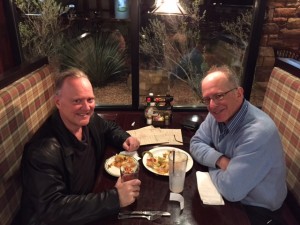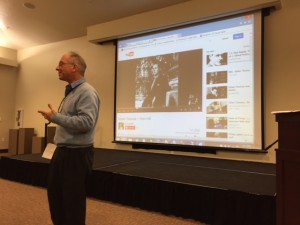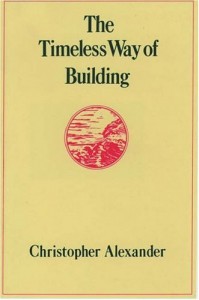By Niles Ritter, Z-Arts Literary Chair
The opinions expressed here are those of the author alone.
Plein-Air Poetry
“A poem is a small (or large) machine made of words.”
–William Carlos Williams
 By the time the last attendees had left and we had closed and locked the Canyon Community Center, it was nine thirty and Dr. David J Rothman still hadn’t eaten. Even in peak tourist season, Springdale is a sleepy little town and the kitchens tend to close around nine, so hopes were slim. I first suggested that Sol Foods market would still be open and we could grab a ready-made sandwich, but then remembered that the Zion Brew Pub over by the park entrance had been doing a lot of business even during the off-season. We drove over there and — miracles! — the pub kitchen was open and we sat down to chat for a few minutes. Some time later, I got a worried call from my wife Gigi, who had given me up for dead and was out on the highway looking for the mangled wreckage of my Jeep. The proprietor of the restaurant finally had to kick us out, but not before taking a commemorative photo of the end of what turned out to be a highly enjoyable, informative and entertaining evening.
By the time the last attendees had left and we had closed and locked the Canyon Community Center, it was nine thirty and Dr. David J Rothman still hadn’t eaten. Even in peak tourist season, Springdale is a sleepy little town and the kitchens tend to close around nine, so hopes were slim. I first suggested that Sol Foods market would still be open and we could grab a ready-made sandwich, but then remembered that the Zion Brew Pub over by the park entrance had been doing a lot of business even during the off-season. We drove over there and — miracles! — the pub kitchen was open and we sat down to chat for a few minutes. Some time later, I got a worried call from my wife Gigi, who had given me up for dead and was out on the highway looking for the mangled wreckage of my Jeep. The proprietor of the restaurant finally had to kick us out, but not before taking a commemorative photo of the end of what turned out to be a highly enjoyable, informative and entertaining evening.
An evening which did not start out as well as I hoped however. Modern technology was failing. A YouTube video of the poet Dylan Thomas reading his poem “Fern Hill” remained tantalizingly mute, only the poet’s lips and the video cursor moving. A technical glitch (I had yet to fix) turned Thomas into the John Cage of poetry, a pianist sitting mute at the piano for four hundred and thirty-three seconds.
Unfazed, Dr. Rothman treated us instead to his live reading of the poem — a reverie on Thomas’s days as a youth spent in the Fern Hill countryside of Wales, and a reflection on the all-to-quick passage of youth. The poem begins:
Now as I was young and easy under the apple boughs
About the lilting house and happy as the grass was green,
The night above the dingle starry,
Time let me hail and climb
Golden in the heydays of his eyes […]
 While we would have liked to hear Thomas reading his own work, upon a later audition of the recording I have to say I much preferred Dr. Rothman’s own impassioned version to Thomas’s poetic vibrato. It is said that the ancient Homeric poets sang their poems, and old recordings of early Twentieth-Century poets seem to me to reflect an operatic affectation peculiar to that time. I tend to agree with former Poet Laureate Robert Pinsky that the sound of the spoken words of a good poem can stand on their own when read naturally, or by Sir Richard Burton.
While we would have liked to hear Thomas reading his own work, upon a later audition of the recording I have to say I much preferred Dr. Rothman’s own impassioned version to Thomas’s poetic vibrato. It is said that the ancient Homeric poets sang their poems, and old recordings of early Twentieth-Century poets seem to me to reflect an operatic affectation peculiar to that time. I tend to agree with former Poet Laureate Robert Pinsky that the sound of the spoken words of a good poem can stand on their own when read naturally, or by Sir Richard Burton.
This is a digression of course. “Fern Hill” is indeed a great example of a “Plein Air” poem, and conveys a specific time, place and feeling through the details found in nature. But how ?
This is the point that Dr. Rothman wished to make in his lecture: in order to write poetry, whether Plein Air or otherwise, it is important to understand what a poem is, how it affects the reader, and what tools are available to effectively express yourself in a poem. The way that he did this was to ask simple questions: how many syllables are there in each line, where are the stresses, if there were any rhyming patterns or alliteration, and so on. Over the next hour he showed how what at first seemed like such a simple piece was very deep in structure, and the work of a great poetic master, every word in its place for important artistic reasons that comes out in the reading.
Such things seem so simple, counting syllables and finding rhymes. A child could do it. But the point of the matter, as David Rothman showed, is that in all art forms there is something being measured by the observer’s mind as it takes in the work, and by the artist as they are exercising their craft: The number of lines on the page, the amount of paint on a canvas, the length of a musical note or the beam in a building. Our minds do these measurements “at the speed of light” and we are not completely aware of the connections we are making. The essence of all art is in many ways Symmetry — the very word itself meaning, “same measure”.
But what is it that we are measuring, and what is the quality of the poem that brings these measurements into focus, and has this impact?
The Quality That Has No Name
When Gigi and I were trying to build a house in Springdale, I read a lot of writing about Architecture, from 
Frank Lloyd Wright and others. One of the lesser-known architects was a fellow named Christopher Alexander, who wrote a book called “The Timeless Way of Building“. In this book he lays out his thesis:
There is one timeless way of building. It is thousands of years old, and the same today as it has always been. […] There is a central quality which is the root criterion of life and spirit in a man, a town, a building, or a wilderness. This quality is objective and precise, but it cannot be named.
The rest of Alexander’s book is spent describing the nature and patterns of this central Quality that cannot be named. In essence, however, it can be summarized by this;
The search which we make for this quality, in our own lives, is the central search of any person, and the crux of any individual person’s story. It is the search for those moments and situations when we are most alive.
Think of a time when a poem has affected you, or a piece of music, a scene in a movie or novel. When have those experiences been the most profound? When did they make you feel the most “alive”? Is there not something — ineffable — in the work that resonates with your own experience? It is said that music affects your sympathetic nervous system; the word “sympathy” itself meaning, “same pain”. Somehow there is a symmetry between the feelings in the music, and your inner feelings. Emotion is being measured, and compared.
In Alexander’s books, he has identified within architecture some simple patterns, or building blocks, which have been seen in every building having this Quality of living structure. He identifies these patterns with simple ALL CAPS names and describes them briefly. Here are a few examples:
SHELTERING ROOF
INTIMACY GRADIENT
Each of these patterns has a purpose, and an explanation for how the purpose is fulfilled. For example, INTIMACY GRADIENT is a design where as you go further into a house, you reach more and more private rooms. A house using INTIMACY GRADIENT is a comfortable house for its inhabitants, who feel safe living there as their private spaces are not immediately exposed to public entrances. Similarly, a house with a SHELTERING ROOF provides a place where one can be outside and enjoy nature, but without being exposed to rain, sun and the elements. There is nothing in these patterns which specify style or culture. They are simply dealing with how humans wish to live their lives on earth.
Listening to Dr. Rothman’s lectures has made me think that he is suggesting that there is also a pattern language for poetry. The word most often used is Form. For example, his assignment to the next day’s class in the Zion Lodge was to write four lines obeying the following patterns:
FOUR STRONG STRESSES IN EACH LINE
THREE PERFECT ALLITERATIONS AMONG THE STRESSES
ANGLO-SAXON WORDS
It was interesting to see how powerful the lines were that people wrote, even though there was no requirement that the lines made any sense at all. In particular, the Anglo-Saxon words tend to be simple mono-syllabic (cow, rock, hill), and have a primal sound to them which lend to the poetry. There are hundreds of other patterns such as SONNET, ODE, ANAPHORA which are well known. Dr. Rothman also mentioned other important patterns of which I had not heard, such as HYPERBATON (wonderful is that word, look it up you should).
The Timeless Way
David Rothman’s talk was followed by an open-mike poetry reading, in which those attending were invited to read a poem, either their own or a favorite poets. Most read their own work. While I was closing down the community center, Dr. Rothman was talking with a young man from Colorado City, who wished to become a poet. The young man seemed so earnest, but in need of such encouragement. I took my time closing up, taking pains not to interrupt their conversation. There are moments when just a few words could make a difference in a person’s life, and this felt to me like one of those times. Dr. David Rothman is passionate about poetry and its potential to bring joy to people’s lives, and if any of that passion could give a young fellow the spark to continue on his journey toward The Timeless Way, to “find those moments when they are most alive“, I’m sure Dr. Rothman was willing to risk missing a dinner or two.

